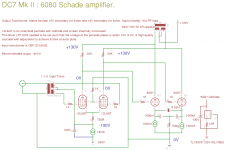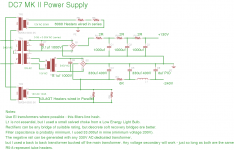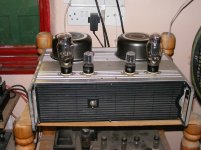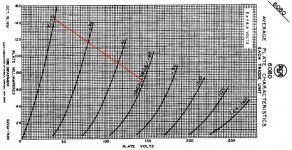Hi all,
A few years ago i built a PP 6080 amp with toroidal interstage phase splitting which I called the DC7. I liked it a lot and others did to, but despite pushing 30mA of driver current through the interstage it still had slight high frequency roll off issues. Eventually I went on to build an adapted Tabor clone with 807's and a front end input transformer phase splitter. This took some getting right, but once done it sounded powerful and detailed. Still it has a very slight amount of pentode edge.
I knew that the 6080 could give magical sounds so I thought about using the principles learned in building the Tabor clone to building a 6080 amp. The eventual design consists of a 12L8GT dual pentode on the front with the grids driven with a little input transformer. i used a negative rail for this which allowed me to tie the screens (common) to the earth rail so simplifying the design. This is direct coupled to the 6080's and the plate's of the 12L8GT are supplied from the output transformer via a 20K resistor.
The output is run at 100V and 100mA per triode and this is tightly regulated with CCS in the cathode. I have bypasssed the cathodes to each other with 1000uf caps in series. This makes the design differential input to output.
The outputs are configured with 100% plate to grid feedback so function purely as current pumps. The output voltage is developed across the 12L8GT 20K plate load which allows for 160V Peak to Peak from just 8mA of plate swing. This gives an input sensitivity of about 2V for full output.
Sound wise it is a bit different to the Tabor clone. It has a very smooth sound with just a hint of Triode bloom. It is detailed with great sound stage and a very powerful bottom end. My sensitive vintage Isophon speakers are easily driven to heavy bass distortion if pushed to hard and this amp is more than capable of pushing them beyond their limits.
I will throw together a schematic later if anyone is interested.
A few years ago i built a PP 6080 amp with toroidal interstage phase splitting which I called the DC7. I liked it a lot and others did to, but despite pushing 30mA of driver current through the interstage it still had slight high frequency roll off issues. Eventually I went on to build an adapted Tabor clone with 807's and a front end input transformer phase splitter. This took some getting right, but once done it sounded powerful and detailed. Still it has a very slight amount of pentode edge.
I knew that the 6080 could give magical sounds so I thought about using the principles learned in building the Tabor clone to building a 6080 amp. The eventual design consists of a 12L8GT dual pentode on the front with the grids driven with a little input transformer. i used a negative rail for this which allowed me to tie the screens (common) to the earth rail so simplifying the design. This is direct coupled to the 6080's and the plate's of the 12L8GT are supplied from the output transformer via a 20K resistor.
The output is run at 100V and 100mA per triode and this is tightly regulated with CCS in the cathode. I have bypasssed the cathodes to each other with 1000uf caps in series. This makes the design differential input to output.
The outputs are configured with 100% plate to grid feedback so function purely as current pumps. The output voltage is developed across the 12L8GT 20K plate load which allows for 160V Peak to Peak from just 8mA of plate swing. This gives an input sensitivity of about 2V for full output.
Sound wise it is a bit different to the Tabor clone. It has a very smooth sound with just a hint of Triode bloom. It is detailed with great sound stage and a very powerful bottom end. My sensitive vintage Isophon speakers are easily driven to heavy bass distortion if pushed to hard and this amp is more than capable of pushing them beyond their limits.
I will throw together a schematic later if anyone is interested.
Here it is.
The 12L8GT might be a tad tricky to get hold of as they are not commonly known. Still there are many out there in dusty corners. I got mine for small money from a great Ebay seller in America, I can probably drag out his details if anyone is interested. Otherwise a pair of small signal pentodes could be installed.
The LTP on the front end wants a bit of adjustement built in so that you can trim the voltage drop across the 20K resistor to 130V. Since the 12L8GT is not particularly linear it is essential to use a high quality cascode design in order to enforce best symmetry and achieve maximum distortion cancellation. I found them easy to drive and had the input transformer configured as a step up initially but found it had far to much gain. If the 12L8GT is unobtainable then any pentode which passes 6.5mA at the plate for 190V on the screen would do fine. I just wanted a four tube PP amp (better to confuse the snobs into thinking it was a super SE amp )
)
Unfortunately there won't be any amp porn as its still in a semi-finished case.
Shoog
The 12L8GT might be a tad tricky to get hold of as they are not commonly known. Still there are many out there in dusty corners. I got mine for small money from a great Ebay seller in America, I can probably drag out his details if anyone is interested. Otherwise a pair of small signal pentodes could be installed.
The LTP on the front end wants a bit of adjustement built in so that you can trim the voltage drop across the 20K resistor to 130V. Since the 12L8GT is not particularly linear it is essential to use a high quality cascode design in order to enforce best symmetry and achieve maximum distortion cancellation. I found them easy to drive and had the input transformer configured as a step up initially but found it had far to much gain. If the 12L8GT is unobtainable then any pentode which passes 6.5mA at the plate for 190V on the screen would do fine. I just wanted a four tube PP amp (better to confuse the snobs into thinking it was a super SE amp
Unfortunately there won't be any amp porn as its still in a semi-finished case.
Shoog
Attachments
6080 is low mu Triode already, what purpose Schading it to an even lower Mu?
I see the 20K, where is the other half of the Schade voltage divider? Surely not
the plate resistance of the twin Pentode?
Normally, we might take a high impedance pentode and Schade it to behave like
a triode. What you've done, defies my ability to Jethro down and cipher...
Does 100% PG feedback make for a Mu of exactly 1?
I see the 20K, where is the other half of the Schade voltage divider? Surely not
the plate resistance of the twin Pentode?
Normally, we might take a high impedance pentode and Schade it to behave like
a triode. What you've done, defies my ability to Jethro down and cipher...
Does 100% PG feedback make for a Mu of exactly 1?
Last edited:
Hi,
Its 100% P to P feedback.
I was making an adjustment yesterday and ran it for a little bit without the heaters on the 6080's. It played at slightly lower SPL but without any authority. So the outputs are indeed working at about a mu of 1. When I built the original DC7 it ran the 6080's without any form of feedback and the gain was still less than 1, so in this situation the gain is no less than running them straight with all the output voltage been developed across the 20K resistor. The 6080's are been asked to do what they do best - which is deliver current.
I estimate the output 6080's impedance at about 100Ohms, and the output triode is working purely as a current pump for the input pair. Sort of like tube current dumping. Anyway it works extremely well with the triode character of the 6080 coming through but with amazing bass punch.
Shoog
Its 100% P to P feedback.
I was making an adjustment yesterday and ran it for a little bit without the heaters on the 6080's. It played at slightly lower SPL but without any authority. So the outputs are indeed working at about a mu of 1. When I built the original DC7 it ran the 6080's without any form of feedback and the gain was still less than 1, so in this situation the gain is no less than running them straight with all the output voltage been developed across the 20K resistor. The 6080's are been asked to do what they do best - which is deliver current.
I estimate the output 6080's impedance at about 100Ohms, and the output triode is working purely as a current pump for the input pair. Sort of like tube current dumping. Anyway it works extremely well with the triode character of the 6080 coming through but with amazing bass punch.
Shoog
6080 is low mu Triode already, what purpose Schading it to an even lower Mu?
I see the 20K, where is the other half of the Schade voltage divider? Surely not
the plate resistance of the twin Pentode?
Normally, we might take a high impedance pentode and Schade it to behave like
a triode. What you've done, defies my ability to Jethro down and cipher...
Does 100% PG feedback make for a Mu of exactly 1?
lessee... 60 gzinta 108 ... uhhhh.... 1.8 times! In-circuit mu is ~1.8
But mu is not particularly a useful metric in this circuit because the output tube is being controlled by it's plate-grid voltage (100% feedback).
There is no feedback divider, p-g voltage = Rf * driver current (f of input voltage) . This is what I've been playing with also.
Effective plate resistance is about 140 ohms based on 1/gm (100% feedback case). This is a good match for the 1400 ohms p-p load.
The Schade feedback here just results in a lower impedance triode.
Should give about 4W power output.
Attachments
Very interesting design. I have some 6336 tubes ( mix of used and new) which I purchased recently. Presume this tube can be used with some adjustment to the voltages to get the same current.
For input I was thinking of using C3g which I have in hand.
Digikey has some 50 VA transformers with two 110V primaries. Would this be suitable in this application? The encapsulation looks similar to Talema.
Any suggestion or comments will be useful.
For input I was thinking of using C3g which I have in hand.
Digikey has some 50 VA transformers with two 110V primaries. Would this be suitable in this application? The encapsulation looks similar to Talema.
Any suggestion or comments will be useful.
Looks like the 6336 would almost be a drop in substitute. I wouldn't run it harder and you should expect longer valve life. Couldn't find a datasheet to suggest the changes.
As to the C3g, again datasheets are hard to come by. The 12L8GT is a very low transconductance tube with about 2mA/V, choosing a higher transconductance valve will increase input sensitivity. The critical thing to consider when substituting is that it needs a plate current of about 6.5mA to drop the right voltage across the 20k plate/feedback resistor. This value is already low so cannot be adjusted down any further to compensate for higher plate current. I really like the 12L8GT as it makes for a two tube per channel amp, and despite its apparently poor curves, the feedback and differential stages correct for this admirably - its also dirt cheap at about $5.00
For the outputs 50VA is lower than I would use, but should be OK. The VA rating points to core size and indicates the Low Frequency power output before saturation - so bigger is better. Mine are about 120VA.
Shoog
As to the C3g, again datasheets are hard to come by. The 12L8GT is a very low transconductance tube with about 2mA/V, choosing a higher transconductance valve will increase input sensitivity. The critical thing to consider when substituting is that it needs a plate current of about 6.5mA to drop the right voltage across the 20k plate/feedback resistor. This value is already low so cannot be adjusted down any further to compensate for higher plate current. I really like the 12L8GT as it makes for a two tube per channel amp, and despite its apparently poor curves, the feedback and differential stages correct for this admirably - its also dirt cheap at about $5.00
For the outputs 50VA is lower than I would use, but should be OK. The VA rating points to core size and indicates the Low Frequency power output before saturation - so bigger is better. Mine are about 120VA.
Shoog
You could push the 6336 to 200mA with a decrease in plate to plate load to about 600Ohms. Or run them at 200V and increase the plate to plate load to about 2400ohms. These are well within the capabilities of the 6336, according to the datasheet, but you will run into problems in heatsinking the CCS's. Mine are simply bolted to the top of the case and they stay about 40 centigrade. Also each 6336 bottle will be dissipating a constant 40W of heat which will keep everything very toasty. Coupled to that is finding a transformer which is happy to run at a constant draw of 80W (plates) + 63W (heaters) will be a challenge. I have a large transformer from a AV amp which runs hot and buzzes quite a bit, I have to use a louvred front plate to keep air circulation up, failure to address this will lead to short amp life as the caps fail.
Shoog
Shoog
ABOUT INPUT TRANSFORMER?
I found some very cheap 600 ohm to 600 ohm matching transformer on ebay, but there's only 1:1 ratio. Can I get two of them to make it 1:1+1 ratio?
NOS tube amp line matching transformer 600 to 600 ohm on eBay.ca (item 400128010681 end time 18-Jun-10 23:24:40 EDT)
I found some very cheap 600 ohm to 600 ohm matching transformer on ebay, but there's only 1:1 ratio. Can I get two of them to make it 1:1+1 ratio?
NOS tube amp line matching transformer 600 to 600 ohm on eBay.ca (item 400128010681 end time 18-Jun-10 23:24:40 EDT)
- Status
- This old topic is closed. If you want to reopen this topic, contact a moderator using the "Report Post" button.
- Home
- Amplifiers
- Tubes / Valves
- DC7 MkII :New Schade 6080 amp.



